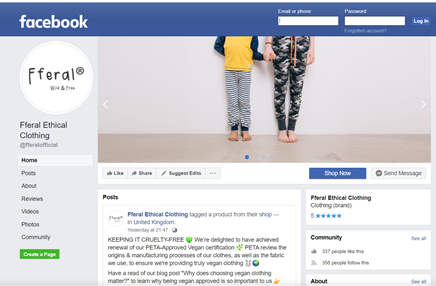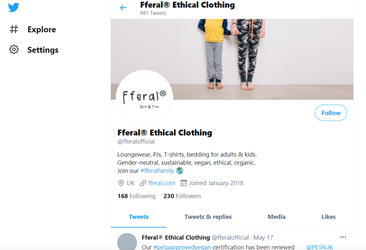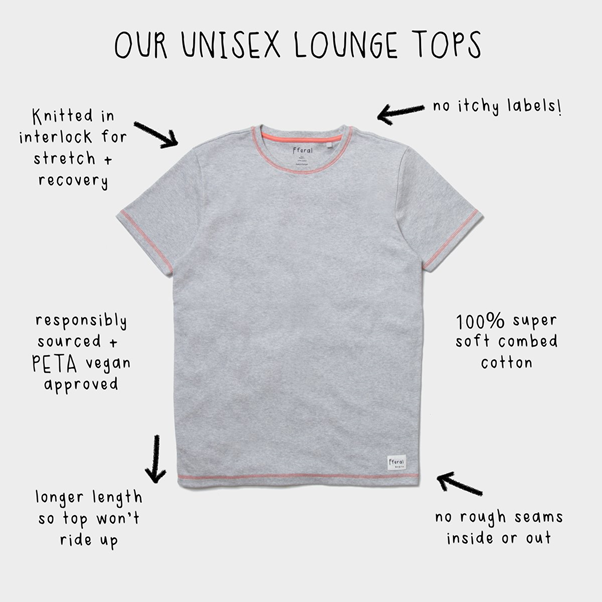Sustainable Consumer Engagement: Case Analysis Of Fferal Clothing
Question
Task:
Sustainable Consumer Engagement: A case study of Fferal Clothing
Fferal Clothing (https://fferal.com/) was launched as an antidote to fast fashion in 2017. Fferal was founded by Helen Tarratt who is a sustainable fashion designer. Starting out as a machinist in a factory in Leicester at the age of 16, she went on to study Textile Design at university before spending 35 years designing clothes for well-known high street brands. Becoming more aware of the damage the fashion industry was doing to our planet, Helen was driven to seek a sustainable alternative. Becoming a mother to a child with autism and Down syndrome gave Helen the push to do something about it.
Throughout the journey from cotton field to customer doorstep, Helen Tarratt worked hard to minimise her impact on the environment. All of her cotton is vegan and sustainably sourced in India. Her pieces are made in Portugal by people earning a proper living wage. Today, Fferal's clothing has become known for their comfort and style, owing to being well-designed, long-lasting and intentionally gender neutral.
Being a new retailer, Fferal Clothing is still at the stage of recruiting and developing their customers. The company needs guidance on how to develop sustainable customer relationships by building a mutually beneficial relationship with its customers. In your coursework, you will write a report for Fferal Clothing by focusing on the four elements of IDIC framework.
Answer
Introduction
The purpose of this study is to develop sustainable consumer engagement and relationships through creating a mutually effective relation with its consumers. This study will ensure an external environment analysis of Fferal Clothing with the analysis and application of IDIC model, Consumer service metric evaluation and recommendations at the end.
Fferal Clothing mission: Company is dedicated to sustainably sourced, 100% cotton, ethically sourced and made cloths for people and cater to their needs (fferal.com, 2021).
Unique selling point: The unique selling point of Fferal Clothing is based on their online, PPC, UX operations are making comfortable Vegan cloths for their consumers. The unique point is based on brand awareness development, new consumer attraction and develop sales of the company (fferal.com, 2021).
Target market and competitors: The target market of Fferal Clothing are children and Adults. The main market competitors identified for the company are Little earth, Toby Tigers, Bright Co for kids wear and Colourful Standard for Adults.
Section 1: PESTLE Analysis
The PESTLE analysis of Fferal Clothing is listed below;
|
Political · The changes of Brexit on the relations with other EU countries can impact on the company. Specifically on the costs, import and export conditions with Portugal as it has a Portuguese factory for making cloths (Cuadros, 2018). · The radical overhaul of customs managements involving VAT on all products shipped to EU is also a concern. |
Economic · Increase in development of rentable cloths, both informal and formal · The employment rates and sudden slowdown of business activities due to pandemic (Hossain et al., 2020, pp.199) · Rise of product costs, specifically the outside sourcing of materials for clothing. Such as, Cotton product, which is Vegan and sourced in India. |
|
Social · Customers’ living style and purchasing style change in the Covid-19 pandemic situation · Health consciousness and sustainable business concerns of customers have increased more in 2020 (Feng and Ngai, 2020, p.2477). · Online buying trends have increased in population as they preferring to stay at home. |
Technological · Development and engagement on different social media platforms of customers is a benefit for Fferal Clothing. · Developing significance of social media marketing for brand awareness, purchasing and supplies. · More need for customer access and convenient (Hossain et al., 2020, pp.196). · Increased rates of social media thefts and data loss. · Need for all-time and customizable assistance for customers on social media platforms (Hossain et al., 2020, pp.197). |
|
Legal · Post Brexit, change in regulations, tax and costs will increase for companies. · Increase in outsourcing some of the functions overseas. · Social media marketing and business rules should be maintained by all the companies (Donnelly et al., 2020, p.102043). |
Environmental · Concerns on waste management, climate change are alarming for companies as well as important to customers (Macchion et al., 2017, p.194). · Sustainable material usage in the products is also a concern for the company. · Lowering the consumption of energy in the sector is also a threat and concern for the company (Yang et al., 2017, p.1266).
|
Table 1: External analysis of Fferal Clothing
(Source: Created by the learner)
Discussion:
From the pestle analysis in Table 1, important factors such as Technolgical, social and environmental have come up as the main concern for Fferal Clothing. The company will require to be well aware of the changing customer preferences for the types of cloths they are marketing or selling in the market. For instance, it can be said that vegan cloths are apparently new concept for most of the customers. Thus, the company needs to create effective awareness program in their social media and PPC activities. This can be done through making short and creative videos on how the cotton used is vegan and how can the vegan cloths will impact on the environmental issues and help in lowering down the adverting effects on planet (Pal and Gander, 2018, p.255). Here, all of the social media platforms can be used for spreading awareness and what is new with the company. This will also help in increasing the brand recognition and brand value of of Fferal Clothing against their market competitors. Customers will get the knowledge of sustainable efforts that the company is making and delivering to the doorsteps of their customers.
On the other hand, as for social media platform and company presence, Fferal Clothing has already an effective hold on the online platforms with its social media marketing through influencers, search engine optimization process and developed UX operations. These will be the opportunities for Fferal Clothing in attracting more attention from their customers. The other secondary factors discussed in the Pestle analysis in Table 1 should also be taken care of. For instance, the political and legal changes after Brexit and how these can impact on the free trading, costs and tax operations of the company. The current Covod-19 issues that have directly influenced on the lifestyle and purchasing capabilities of their customers are also important for Fferal Clothing (Becker-Leifhold, 2018, p.784). Changing in clothing prices and stock availability to customers are also linked to this factor.
Section 2: Applying IDIC Framework to Fferal Cothing
The IDIC framework is a CRM model for understanding the consumer needs and assess company actions (Deszczy?ski, 2018). As per the IDIC approach, companies must take different functions to create closer one-to-one relations with their consumers. The IDIC framework application for Fferal Clothing is listed below;
Figure 1: IDIC approach explained
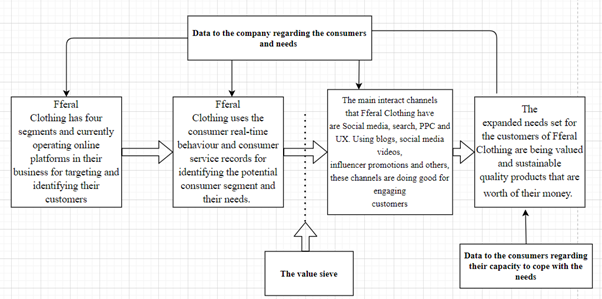
(Source: https://app.diagrams.net/)
2.1 Identification
Fferal Clothing has four segments and currently operating online platforms in their business for targeting and identifying their customers. These segments are divided into four parts as Social media, search, PPC and UX. Among these the PPC and UX platforms are effective in pointing out the specific demographics of customers that are visiting or reading contents. For example, it has been reviewed that the social media and Instagram advertisement through influencers, bloggers can be taken as good approach to identify if the young adults and family people, specifically mothers are interested in their clothing and products are not (Ahn et al., 2021). Additionally, the social media giveaways, follower growth analysis Click throughs to the online store are also additional appeals for the customers to visit the store and Fferal Clothing get the idea of what types of customer segment needs cloths for their daily usage, what types of customers like their marketing approach and others (Nazeri et al., 2020). On the other hand, the added consumer review app and inviting old customers to enter review is another good way for Fferal Clothing to identify the gap and unique or individual needs and experiences of customers. This helps the company in building engagement and trust among loyal consumers (Ahn et al., 2021).
Need for improvement
Application of big data analytics is essential for the company in future if it expands the market presence, as it will help in improving consumer experiences through customization (Ahn et al., 2021).
2.2 Differentiation
The customer differentiation should always be based on the needs and values of consumers. In this case, Fferal Clothing uses the consumer real-time behaviour and consumer service records for identifying the potential consumer segment and their needs. The website activity and social media presence is effective for underlying the tastes and preferences of different customers (Ghahroudi and Sagheb, 2018). For example, if any customer segment is presence most of the time on Instagram and other social media platforms and they have a higher searching history in the feed and product segments of Fferal Clothing, then this segment of customers can be considered as the need-based or new customers. They can be targeted and promotional contents should be presented as per their needs.
On the other hand, purchasing values, frequency and average purchase value of parents differ from the young customers who belong to the Gen-z or Millennials group of Fferal Clothing. Calculations of these parameters are important for the company to know what is the exact customer value of different customer segments (Dahana et al., 2019). Thus, Fferal Clothing needs to identify what consumer segment is generating most of the value to the business. Upon identifying this, they can evaluate their relationship management strategy. For instance, if Gen-Z customers are purchasing products from the consumers influenced by the social media personal or influencer promotions, then they are valuing their personal tastes and popular trends in the market.
|
Different segments |
Main points |
|
Gen-z group of Fferal Clothing |
More social media and online purchasing oriented. |
|
Millennials group of Fferal Clothing |
Social media presence is high than older generation though product quality and price matters also. |
2.3 Interact
The main interact channels that Fferal Clothing have are Social media, search, PPC and UX. Using blogs, social media videos, influencer promotions and others, these channels are doing good for engaging customers. However, developing trust and customer involvement in future with the operations of Fferal Clothing is the primary concern here. Social networking and e-mail referrals and promotions on offers and rewards are effective for Fferal Clothing to use the potential customer data and send them customized messages. These will encourage customers to click or visit the online store and purchase more.
Areas identified as improvement
On the other hand, as Fferal Clothing has a developed social media presence and customers are well aware of this fact, the marketing team should direct the activities and need of their customers in SM for enhancing customer relations and listen to them (Amendola et al., 2018). For example, the customer review app can be used here for listing to the personal experiences and encourage customers to share how clothing has impacted on their styles and personal tastes in daily life. Thus, a better relationship with customers can be developed where they will feel more valued.
The crowd service approach can be liked with the customer review app of Fferal Clothing. Here, customers can be divided into the frequent purchasers, occasional purchaser and so on. This approach can be used for developing a group of consumers who are either purchased from the company before or interested in the type of products Fferal Clothing selling (Ghanadpour and Shokouhyar, 2021). In the customer review app; contest regarding innovative product marketing or social media video with the cloths purchased from Fferal Clothing can be developed. This will encourage customers to input their personal ideas and criticisms. Winner of the contest should be awarded by free merchandise and gifts from the company.
2.4 Customise
For Fferal Clothing, MVCs are customers who regularly purchase for them and for their family members. The MGCs are the young adult population aged between 18-24, who are interested in vegan cloths and sustainable business operations. Mostly, the cloths and unisex designing cloths are most popular for the customers (Thorisdottir and Johannsdottir, 2019). For instance, customization of services and products ned to be done by the company to target their customers and this is the main need currently identified by the business. The expanded needs set for the customers of Fferal Clothing are being valued and sustainable quality products that are worth of their money. These have been identified through the analysis of customer purchasing habits and recent purchasing list.
Application of mass customization for Fferal Clothing can be done through transparent customization process. As per the information collected, Fferal Clothing is able to identify the basic needs and preferences of their customers in their customer review app. Utilization of these data for producing and offering standard packages for customers can be helpful (Thorisdottir and Johannsdottir, 2019).
2.5 Comparison of Fferal Clothing with competitors
From the market and products with fan appeal of Little Earth, it has been identified that mass appeal and mass customization platform are effective and strong for this company. With the developed brand awareness and different partnerships with retail wholesalers, Little Earth has already good in consumer relationship management (littlearth.com, 2021). It has been identified that they have a wider range of customizable products for their customers, which is not only limited to clothing but for different accessories for their pets too. This implies that customers will be more engaged in the company product segments. On the other hand, Little Earth is dedicated in developing a network with all types of customers (littlearth.com, 2021). This mass network helps them to realize what their customers’ needs and preferences. Against, to this, Fferal Clothing is still growing their market and brand presence. They lack in mass customization and crowd service approach for their target customers. The sharp contrast between an already consumer needs identification capability between these two companies are evident here.
Toby Tigers, organic and cotton baby clothing brand is popular for their good consumer delivery and communication services (tobytiger.co.uk, 2021). It has been reviewed that fast delivery to the customers and a sustainable way of packaging is what the company stands for some of the customers. Though Fferal Clothing is also doing a good work on developing their vegan clothing line and services, Toby Tigers is ahead from them in their organic and compostable packaging services. This company is also well known for providing products to their customers that are affordable, yet organic and as per the market review information, most of the consumers are satisfied with their cost-effective and quality product styles.
The company Bright Co LTD for kids wears has an extensive online and offline presence. These two types of business presences help communicating with different types of consumers who are technology known and are not technology comfortable. Capturing two different types of markets has helped Bright Co LTD in expanding their market in the niche customer segment, who are considered as their regular and premium customers (thebrightcompany.uk. 2021). The product reviews are also good. Against the competitor, Fferal Clothing has only a social media based online presence. This company lacks in offline markets, which for many of the customers is also a valuable point of judging and measuring the quality of products while purchasing them that cannot be done online.
Colourful Standards; has an innovative outlook and the brand stands for this. They are very well-known and is not on limited resources as compared to Fferal Clothing. The strong international presence and branding techniques are effective of this company. They have an approach of targeting the global audiences, that are mainly adults and sell their clothing items as per their tastes (fashionnetwork.com, 2021). Thus, they follow a Cosmetic mass customization approach to engage and appeal to their customers. Fferal Clothing has limited resources and presence on the market, however, the customer acceptance on the clothing line and other products of Fferal Clothing is also growing effectively.
Section 3: Customer Service Metrics Analysis
Net Promoter Score (NPS): This consumer service metric can be used by Fferal clothing company for identifying their consumers’ loyalty on specific products (Fisher and Kordupleski, 2019). The NPS promoter score can be applied by the company to become more concentrated in developing services or products. Although, it has to be remembered that as the NPS includes a survey of consumers’ responses through emails; there will be some reliability and validity between the NPS and other metrics (Eger and Mi?ík, 2017). Although, calculating the NPS promoter score registered in the survey results from passives, Fferal clothing company can identify what types of products consumers are wanting more in the market.
Customer Satisfaction Score (CSAT): The consumer retention and repurchase indicator can be used by Fferal clothing company for identifying what factors are contributing to the interests of their main target market and what factors are not important (Nwachukwu and Žufan, 2017). For example, if the results are showing that price of some products and quality of some products are influencing consumers to repurchase and developing their brand loyalty, the Fferal clothing company needs to concentrate more on quality improvement of their products without increasing prices too much in new product segments (Wang et al., 2019). This way, consumers will feel valued by the company and will remain loyal to it.
Customer Effort Score (CES): This metric involves Likert scale survey of consumers online for identifying how they are ease of using the products from any company they have purchased (Williams et al., 2020). Fferal clothing company can apply this online service as the after sell or purchase survey of their consumers and identify how their purchased items are really useful to them or not (Joshi et al., 2017). If the score is higher, then they can further decide on the production developing and supply of the same materials and products in the market.
Customer Lifetime Value (CLV): This metric will underline what amount of investment any target consumer or target group of customers will spend on the business or on products during their lifetime (Chiang and Yang, 2018). Adding up the money collected from a consumer can be included in the calculation process. This metric will help Fferal clothing company in determining how much time a consumer will spend on them and what types of products they will purchase and in which frequency level (Dahana et al., 2019). This metric will also can be used by Fferal clothing company in determining if the marketing or promotional tactics and offers provided by them are impacting any consumer to purchase more or not.
Average Ticket Time: This metric can be used by the clothing retail company in case of sales and profitability analysis. Calculations of Avarage ticket time of online clothing orders of particular segment of customers need to be done by the company (Chen et al., 2018). The shopping cart abandonment levels also need to be included in the calculations. After doing so, the level of investment company has done on developing and marketing the products and how they are able to attack customers’ conversion can be identified.
Section 4: Recommendations
Transparent customization process
Application of mass customization process for Fferal Clothing has been mentioned in this report above. This mass customization method will be Transparent customization as per the needs of current and future customers of Fferal Clothing. The internet shopping for Vegan cloths for is developing currently and the platform offered the interactivity important to include customers in the design procedure. For this asking customer specific questions will be effective. As the company already has a customer review app, promotion on this app and through e-mails for the survey can be done. In this survey, queries regarding clothing style and new product ideals can be asked. In this way, a mass need for new products and for the clothing style can be collected (Vekic et al., 2020, pp.24). The information later can be turned into production of mass customizable products for the target customers. In this way, customers will feel valued and they will be more willing to share their opinions on later stage also. The new Vegan cloths for kids, unisex items and both formal and informal clothing segments can then be customized in a way that can appeal all types of customers. For example, selective changes in the colours or producing night wears for all ages of customers as they wanted.
Figure 2: Customization process benefits
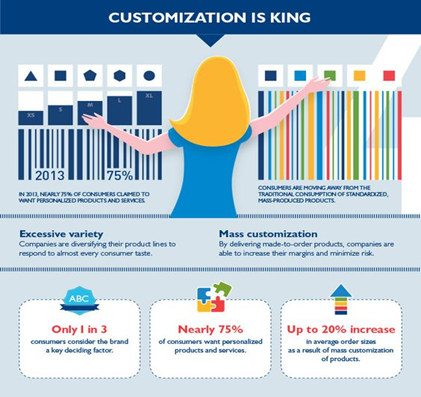
(Source: Ison et al., 2020)
Crowd service platform development
The crowd service platform can be developed by the company linking their social media platforms and website. Fferal Clothing can on a monthly basis ask their customers for their ideas, inputs on the promotional and other operations of the company. In this process, encouragement should also be made to submit own ideas of the customers (Nasta and Pirolo, 2019). For instance, an event promotion for the online community development can be done by the company. This will be based on social media. Different social media platforms will be included in this event. It can be said that multi-tasking should be done by the marketing experts in collecting the responses of the customers. In this community, design, packaging, price and other matters regrading clothing manufacturing can be done. This will help the company in developing two-way communication with their customers and they will be more comfortable in sharing new ideas (Blohm et al., 2018, pp.131). The working loads will be minimized for the product design teams as they will know what changes consumers are demanding. In some cases, freelancers can be hired by the company from the community and rewarding customers whose idea will be finalize should also be done.
Figure 3: Crowd service platform
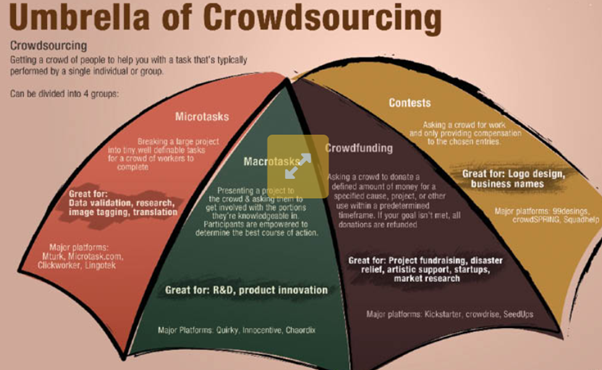
(Source: Nasta and Pirolo, 2019)
Virtual try on cloths
Application of deep learning technologies for customers to try cloths online will be the next stage of change for Fferal Clothing. In this regard, the IT team in this company should develop AI algorithms and pattern and vision recognition function for their customers. This platform will allow customers for selecting and finding variations on different product images, while other will suggest products, which go with products a consumer has already identified (Dong et al., 2019, pp. 9028). On the other hand, a 3rd synthesizes an image of model wearing outfits from various product pages to underline how products work together as a clothing. Customer images can be used for comparing and portraying how they will look wearing the cloths (Dong et al., 2019, pp. 9029). This is the process of making customers more independent in purchasing and making their experiences more comfortable.
Figure 4: Sample for virtual try on cloths
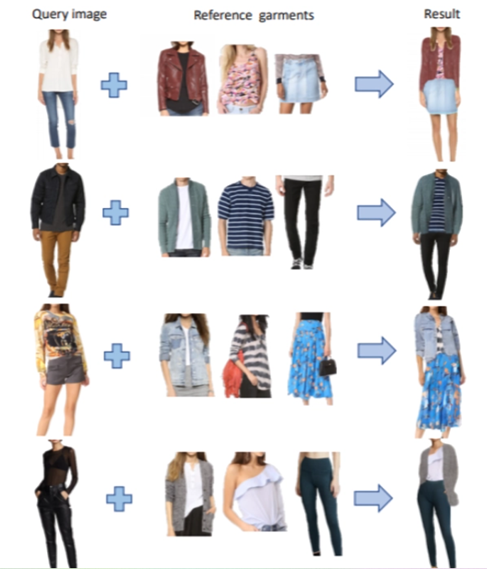
(Source: Dong et al., 2019, pp. 9030)
Bigdata application for customer experience
Inclusion of Bigdata in the social media and promotional operations of Fferal Clothing will help connecting more customers with the company in future. Understanding big data to understand how their customers are feeling emotionally is necessary here. It can be said that data sources might involve formal surveys, social media feedbacks, call transcripts as well as virtually any other exchanging among Fferal Clothing and the customers (Holmlund et al., 2020, pp.359). Using soft language, emotionally charged videos and marketing and personalized campaigns will help understand and connect more consumers with the company.
Social CRM application
Fferal Clothing should apply the social CRM application or develop their CRM strategy to the social media platforms for understanding active number of followers and how they are communicating with the contents of the company (Kim and Wang, 2019, pp.44). If there is discrepancy in the active followers’ numbers, then the reasons of not connecting with the contents can also be known to Fferal Clothing.
How can Fferal Clothing use customer data and analytics to offer a better value to its customers?
Data collected from google analytics and different social media analytics will help Fferal Clothing to identify what types of customers are more frequently visiting to their websites, their tastes, search results, demographics and others. These are the fundamental, yet important consumer data, which will help the company to target more valuable consumer segment in the market. Catering to their specific needs and tastes of clothing will be more accurate in this case. On the other hand, implementation of big data and google analytics can help Fferal Clothing to predict consumer behaviours when they are trying to promote new clothing items and their decision-making process can be influenced and customers can be encouraged to buy the items with specific types of advertisements.
Conclusion
This study has been based on the motive and target of Fferal Clothing in developing their communication and relationship with consumers online. This study has identified opportunities and threats of Fferal Clothing in their external business environment and applied the IDIC model with customer service metric and stated effective recommendations that can help them achieving their main target.
References
Ahn, J., Shamim, A. and Park, J., 2021. Impacts of cruise industry corporate social responsibility reputation on customers’ loyalty: Mediating role of trust and identification. International Journal of Hospitality Management, 92, p.102706.
Amendola, C., Calabrese, M. and Caputo, F., 2018. Fashion companies and customer satisfaction: A relation mediated by Information and Communication Technologies. Journal of Retailing and Consumer Services, 43, pp.251-257.
Becker-Leifhold, C.V., 2018. The role of values in collaborative fashion consumption-A critical investigation through the lenses of the theory of planned behavior. Journal of Cleaner Production, 199, pp.781-791.
Blohm, I., Zogaj, S., Bretschneider, U. and Leimeister, J.M., 2018. How to manage crowdsourcing platforms effectively?. California Management Review, 60(2), pp.122-149.
Chen, L., Ayanso, A. and Lertwachara, K., 2018. Performance Impacts of Web-Enabled Retail Services: An Empirical Study. Journal of Computer Information Systems, 58(4), pp.301-311.
Chiang, L.L.L. and Yang, C.S., 2018. Does country-of-origin brand personality generate retail customer lifetime value? A Big Data analytics approach. Technological Forecasting and Social Change, 130, pp.177-187.
Company, T., 2021. OUR STORY. [online] The Bright Company. Available at:
Cuadros, natalie, 2018. Bremaining in Vogue: The Impact of Brexit on the Fashion Industry. Am. U. Bus. L. Rev., 7, p.129.
Dahana, W.D., Miwa, Y. and Morisada, M., 2019. Linking lifestyle to customer lifetime value: An exploratory study in an online fashion retail market. Journal of Business Research, 99, pp.319-331.
Dahana, W.D., Miwa, Y. and Morisada, M., 2019. Linking lifestyle to customer lifetime value: An exploratory study in an online fashion retail market. Journal of Business Research, 99, pp.319-331.
Deszczy?ski, B., 2018. The integrated relationship management framework. Ekonomia i Prawo. Economics and Law, 17(1), pp.17-31.
Dong, H., Liang, X., Shen, X., Wu, B., Chen, B.C. and Yin, J., 2019. Fw-gan: Flow-navigated warping gan for video virtual try-on. In Proceedings of the IEEE/CVF International Conference on Computer Vision (pp. 1161-1170).
Donnelly, S., Gee, L. and Silva, E.S., 2020. UK mid-market department stores: Is fashion product assortment one key to regaining competitive advantage?. Journal of Retailing and Consumer Services, 54, p.102043.
Eger, L. and Mi?ík, M., 2017. Customer-oriented communication in retail and Net Promoter Score. Journal of Retailing and Consumer Services, 35, pp.142-149.
FashionNetwork.com. 2021. Colorful Standard picks Paris as home of first monobrand store. [online] Available at:
Feng, P. and Ngai, C.S.B., 2020. Doing more on the corporate sustainability front: a longitudinal analysis of CSR reporting of global fashion companies. Sustainability, 12(6), p.2477.
Fferal. 2021. Fferal Sustainable Clothing. [online] Available at:
Fisher, N.I. and Kordupleski, R.E., 2019. Good and bad market research: A critical review of Net Promoter Score. Applied Stochastic Models in Business and Industry, 35(1), pp.138-151.
Ghahroudi, M.R. and Sagheb, S., 2018. The impact of differentiation strategies on the women fashion clothing performance. Journal of Economics and Business, 1(4), pp.381-400.
Ghanadpour, S.H. and Shokouhyar, S., 2021. Using Social Media in Open Innovation: Opportunities and Challenges. Journal of Advances in Information Technology Vol, 12(1).
Holmlund, M., Van Vaerenbergh, Y., Ciuchita, R., Ravald, A., Sarantopoulos, P., Ordenes, F.V. and Zaki, M., 2020. Customer experience management in the age of big data analytics: A strategic framework. Journal of Business Research, 116, pp.356-365.
Hossain, S.F.A., Shan, X., Musa, M. and Rahman, P., 2020. Social media and increased venture creation tendency with innovative ideas: the case of female students in Asia. In Handbook of research on managerial practices and disruptive innovation in Asia (pp. 194-209). IGI Global.
Ison, M.G., Wolfe, C. and Boucher, H.W., 2020. Emergency use authorization of remdesivir: the need for a transparent distribution process. Jama, 323(23), pp.2365-2366.
Joshi, S., Bhatia, S., Raikar, K. and Pall, H., 2017. Customer experience and associated customer behaviour in end user devices and technologies (smartphones, mobile internet, mobile financial services). International Journal of High Performance Computing and Networking, 10(1-2), pp.118-126.
Kim, H.G. and Wang, Z., 2019. Defining and measuring social customer-relationship management (CRM) capabilities. Journal of Marketing Analytics, 7(1), pp.40-50.
Little Earth Productions. 2021. About Us. [online] Available at:
Macchion, L., Moretto, A., Caniato, F., Caridi, M., Danese, P., Spina, G. and Vinelli, A., 2017. Improving innovation performance through environmental practices in the fashion industry: the moderating effect of internationalisation and the influence of collaboration. Production Planning & Control, 28(3), pp.190-201.
Nasta, L. and Pirolo, L., 2019. Crowdsourcing in the Fashion Industry. In Toward Super-Creativity-Improving Creativity in Humans, Machines, and Human-Machine Collaborations. IntechOpen.
Nazeri, P., Tajdin, A. and Ebadi, S., 2017. The impact of customer knowledge and customer relationship management in the quality of services in the insurance company Sarmad. Research in Economics and Management, 2(4).
Nwachukwu, C. and Žufan, P., 2017. Influence of Customer Focused Mission Statement on Customer Satisfaction. Acta Universitatis Agriculturae et Silviculturae Mendelianae Brunensis, 65(3), pp.1031-1038.
Pal, R. and Gander, J., 2018. Modelling environmental value: An examination of sustainable business models within the fashion industry. Journal of Cleaner Production, 184, pp.251-263.
Thorisdottir, T.S. and Johannsdottir, L., 2019. Sustainability within fashion business models: A systematic literature review. Sustainability, 11(8), p.2233.
Toby Tiger. 2021. Colourful Organic Cotton Baby & Kids Clothes | Toby Tiger. [online] Available at:
Vekic, A., Borocki, J. and Fajsi, A., 2020. Mass Customization Strategies in Pandemic Conditions. In 9th International Conference on Mass Customization and Personalization–Community of Europe (MCP-CE 2020) Re-innovating Business in the Digital Era (pp. 23-25).
Wang, H., Liu, H., Kim, S.J. and Kim, K.H., 2019. Sustainable fashion index model and its implication. Journal of Business Research, 99, pp.430-437.
Williams, L., Buoye, A., Keiningham, T.L. and Aksoy, L., 2020. The practitioners’ path to customer loyalty: Memorable experiences or frictionless experiences?. Journal of Retailing and Consumer Services, 57, p.102215.
Yang, S., Song, Y. and Tong, S., 2017. Sustainable retailing in the fashion industry: A systematic literature review. Sustainability, 9(7), p.1266.
Appendix
